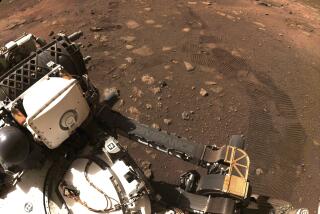The Left Stuff
PASADENA — Wayne Sidney occupies one of those ubiquitous “workstations” of the modern office. His cubicle is one in a maze of cubicles, each uniformly defined by cloth partitions, decorated in earth tones and equipped with a computer. At a glance, this might be a place where insurance forms are processed or expense accounts reviewed. It is not.
What Sidney and his co-workers do, remarkably enough, is control a spaceship bound for Mars, and one Saturday night in late August they ran into a bit of trouble--”an anomaly,” Sidney called it.
A systems engineer on contract to NASA’s Jet Propulsion Lab, Sidney had designed and sent aloft to the Mars Observer a set of computer commands that would insert the craft into orbit around the planet. According to his sequence, as it is called, at 5:40 p.m. Saturday, Aug. 21, the spacecraft would shut down its communication systems--a precaution against damage to on-board electronics--and then pressurize and fire its steering thrusters. The satellite was to complete the maneuver and restore contact in 20 minutes. In the meantime, Sidney and his cohorts could do nothing but stare at frozen computer screens and wait.
Two weeks later, they are waiting still.
*
Much as the landing strips of the Mojave once were a magnet for the hot young test pilots chronicled in “The Right Stuff,” JPL is a proving ground for hot young computer wizards, mathematicians and aerospace engineers. These possessors of the Left Stuff, if you will, are drawn here by a desire to take theory to its highest practical extension, to design and operate the Voyagers and Pioneers and other unmanned space probes that NASA sends looping through the solar system.
Sidney is typical of the breed, a thin, unassuming young man who still is teased about the pocket protector he wore the first day on the job. His father was an Air Force jet fighter mechanic, his mother an astronomy buff. He studied aerospace engineering in college, cut his teeth on the Titan rocket program, moved into satellite design and, four years ago, just 26 years old, came here to work on the $1-billion Mars mission. He has the bug. He speaks with bright eyes of the “romantic side” of his work, the “Star Trek” mentality. He speaks as well of feeling “attached” to the Observer, of the sense that it is almost an extension of himself, hundreds of millions of miles out, hurtling toward Mars.
And now, returning to that Saturday night in August, it was in trouble. After 20 minutes elapsed, Sidney’s computer screen did not come alive. This happens sometimes, he told himself, the timing can be off a few minutes. Ten minutes more and still nothing. Colleagues crammed into his cubicle. There was gallows humor, but later he could not recall the jokes. What he could remember was a frozen computer screen and a feeling deep in his stomach. Another 10 minutes, nothing. A half hour, nothing. An hour, nothing.
“We were prepared for many anomalies,” Sidney would say. “What we were not expecting was to get back nothing.” Understanding came in waves that first, frantic night. “My feeling was a deep sense that something dreadful had happened,” he said later, “but I would not accept it.”
*
Two weeks have passed, and still nothing. There are many theories about what went wrong, but basically they boil down to this: Either the spacecraft is out there somewhere, flying dark around Mars, dead in the water, or it was blown to bits during the thruster procedure. Sidney suspects the worst--that his “baby,” as he calls it, met an end that was “totally violent.” He almost shudders as he says it.
He has since retraced his steps, convincing himself he did not misprogram the spacecraft. “That was a damn good sequence,” he said. It’s a long shot, but he and the others keep beaming up new computer sequences, hoping to re-establish contact with the spacecraft. If there is a spacecraft. They have tried 400 sequences so far, and they are beginning to run out of ideas.
The first few days were the most hectic, with an intensity that suspended time. The high, neat stack of empty cans in his cubicle suggests Sidney got by on a diet of Mountain Dew. Finally, late one night, driving home to Santa Clarita, alone, drained, it all caught up with him. And he began to cry.
There was so much to figure out. Where, for instance, would he work now? His wife is expecting, and the condominium might be tough to sell. Those were the personal pressures. He also wept, he said, “for what might have been, for the loss, for all the work we did, four years, and then to have all that wiped out by one command execution. Just like that.” He snapped his fingers and stared at his computer screen.
It stared back.
More to Read
Inside the business of entertainment
The Wide Shot brings you news, analysis and insights on everything from streaming wars to production — and what it all means for the future.
You may occasionally receive promotional content from the Los Angeles Times.











